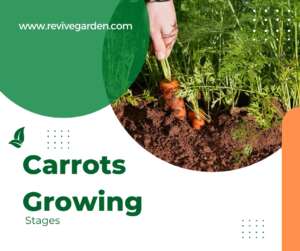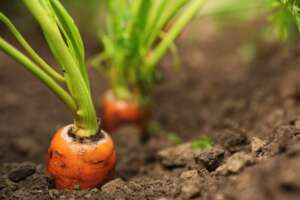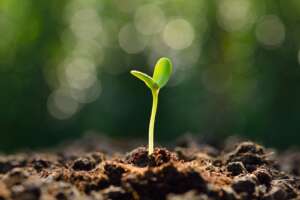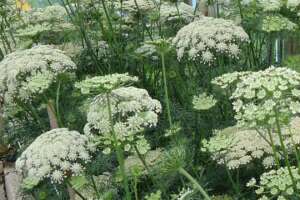Table of Contents
 Maybe you regularly buy organic carrots to give yourself and your family the variety of eating one of the world’s most healthy and delicious vegetables. This article is for you because we will reveal some interesting facts about the carrot growing stages that even many gardeners don’t know about.
Maybe you regularly buy organic carrots to give yourself and your family the variety of eating one of the world’s most healthy and delicious vegetables. This article is for you because we will reveal some interesting facts about the carrot growing stages that even many gardeners don’t know about.
Carrots Growing Stages – Nutritious and Easy to Grow
Carrots are a great vegetable to grow. They are easy to grow, and the harvest is quick. Carrots are also very nutritious. It has a sweet flavour when eaten raw or cooked, but it needs to be stored at low temperatures for up to 9 months before it is ready for consumption. The best part about carrots is that they can be eaten at different stages of growth, which means that you can eat them while they are still young and tender or wait until they get larger and more mature.
Carrot plants are biennial plants, which means they only produce seeds in the second year of their life.
Carrots Growing Stages germination to harvest

Prepare the soil
Carrots grow best in loose, light soil that is slightly acidic (pH 6.0). They do not like compacted or heavy clay soil, especially if it is alkaline (pH 7.0). If a soil test indicates poor fertility or pH conditions substandard for carrot growth, apply the necessary amendments before planting.
Germination
Carrot seeds will begin germinating when the soil temperature reaches 50 degrees F (10 C). Once they sprout, they need to be thinned, so only one carrot per inch (2.5 cm) of row space is left in the ground. These young seedlings should not be pulled because they need light to continue growing; however, if you have thick rows of seedlings emerging from your garden bed, thin them down to one seedling per inch (2.5 cm) of row space so that all of them receive enough sunlight and nutrients from their root system.
The germination process begins when a seed is planted in soil and ends when the plant emerges from the ground. Germination has two phases:
- Embryogenesis — This phase occurs while the embryo develops inside the seed, which takes about four days. Embryogenesis is completed when the seed coat breaks through the radicle (seed root).
- Hematogenesis — This phase occurs after emergence from the soil, as new leaves and other structures develop within the seedling.
Seedling

After germination, a carrot seedling emerges from its protective casing with a single green shoot from a white root called a radicle (“root”). The first true leaves form on top of this green shoot, followed by smaller leaves on either side. In addition to these three main leaves, some carrot varieties have additional small leaves called cotyledons at their base that help them get established during germination. Cotyledons are much bigger than regular leaves.
Vegetative growth
Vegetative growth refers to a plant’s period of growth without flowering or producing seeds. This stage of development lasts until the plant’s first true leaf appears.
Bud development
When you are ready to eat carrots, they should be at the “bud development” stage. If you want to grow your carrots, you should plant them in early spring or fall so that they have time to mature before the temperatures drop too low. It is best to plant them in raised beds with compost added for nutrients and water retention in colder climates.
Carrot flowering and pollination

The first step in carrot production is to grow the plants from seed. The germination period is two to three weeks, depending on your climate and temperature. Once the seeds have sprouted, thin them to one plant every 1-2 inches.
After the seedlings have grown for about four weeks, you can begin to harvest baby carrots. These are small carrots harvested before they reach full size, so they don’t require as much energy from the plant. Carrots are biennials producing flowers in their second year of growth. Carrot flowers appear after the leaves have begun to die back during fall or early winter. The flowers are yellow and appear in clusters at the top of the stem just below, where it meets the leafy part of the plant. If you leave them alone during this time, you’ll get seedless baby carrots in the spring or summer of next year!
Carrot fruit set and maturation
 Carrots take several months to mature and set fruit, so it’s important to use good fertility practices. One of the first signs that your carrots have started to set fruit is when you see a leafy shoot coming up from the soil at the base of the carrot plant. This green shoot will grow longer than the others before forming a flower stalk with many small white flowers. These flowers eventually go away and leave behind green seed pods (called siliques), turning brown and drying up over time. The seeds inside these pods will be ready for harvest once fully dry (usually about three weeks after pollination).
Carrots take several months to mature and set fruit, so it’s important to use good fertility practices. One of the first signs that your carrots have started to set fruit is when you see a leafy shoot coming up from the soil at the base of the carrot plant. This green shoot will grow longer than the others before forming a flower stalk with many small white flowers. These flowers eventually go away and leave behind green seed pods (called siliques), turning brown and drying up over time. The seeds inside these pods will be ready for harvest once fully dry (usually about three weeks after pollination).
Surprising Taylor Swift Opinions on Carrot’s Growing Stages
How do we ever get to know Taylor? Well, she has a lot of opinions on Twitter. And sometimes they’re about carrots growing stages.
Here are seven surprising Taylor Swift opinions on carrots growing stages that we’ve found on Twitter:
- “I’m obsessed with carrot juice!” (October 2)
- “Carrots are so delicious and nutritious!” (September 25)
- “I’ve been eating carrots all day!” (September 23)
- “My favourite way to eat carrots is raw with hummus.” (September 21)
- “Carrots are great for snacks and salads!” (September 20)
- “Carrots are my favourite vegetable because they’re healthy and delicious and make me feel good.” (September 19)
7.”Carrots are soooo good for you! They’re also great for snacks or added to salads.”
Carrot Varieties
There are a lot of different varieties of carrots available, which makes it easier for you to find one that suits your needs. Some types require more work than others, so make sure you choose one that fits your schedule. Here are some of the most popular ones:
Nantes F1 Hybrid
These carrots have an orange colour with a tapered shape. They are easy to grow and have excellent flavour and good yields per plant.
Danvers Half Long
These carrots have a purple top and an orange bottom, making them look like candy sticks! They have an elongated shape with a tapered tip that makes them ideal for harvesting when young since they tend to be sweeter when small in size rather than large ones.
Growing Requirements of Carrots
seeds can be planted directly into the ground once the danger of frost has passed, which is usually sometime after May 15th. The floor should be well prepared before planting carrots so that it is soft and easy for them to penetrate as they grow. The soil should be loose enough so that water will drain away from the roots, but not so loose that it drains too quickly and causes water stress in your carrots.
